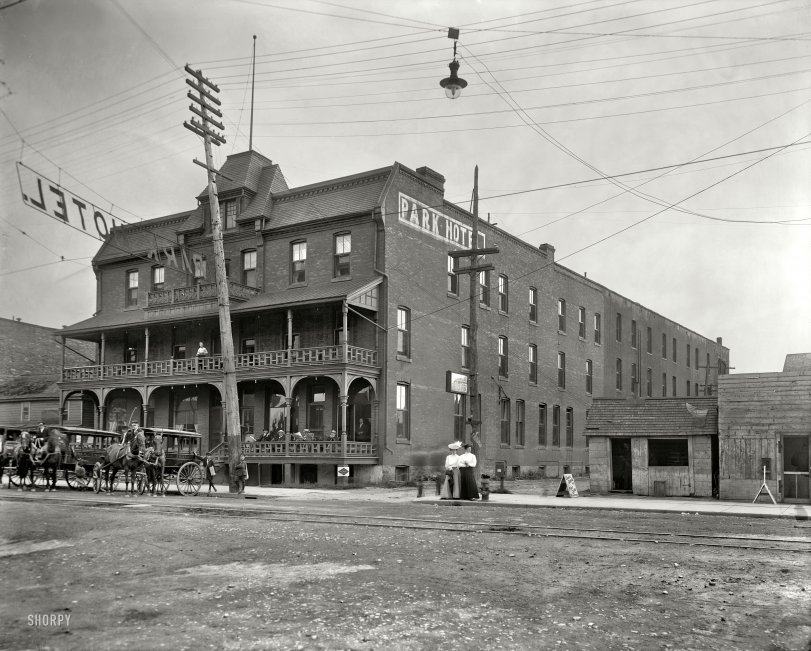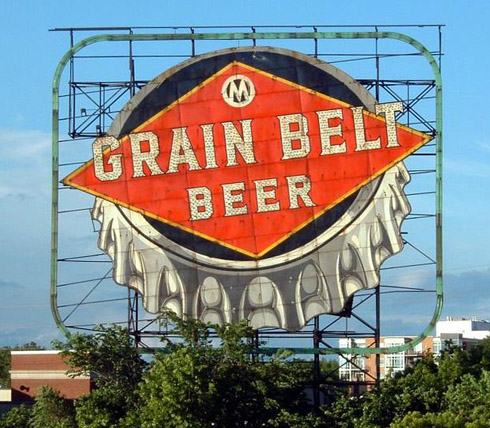


Framed or unframed, desk size to sofa size, printed by us in Arizona and Alabama since 2007. Explore now.
Shorpy is funded by you. Patreon contributors get an ad-free experience.
Learn more.

- Baldwin 62303
- Baldwin VO-1000
- Cold
- No expense spared
- Tough Guys
- Lost in Toyland
- And without gloves
- If I were a blindfolded time traveler
- Smoke Consumer Also Cooks
- Oh that stove!
- Possibly still there?
- What?!?
- $100 Reward
- Freeze Frame
- Texas Flyer wanted
- Just a Year Too Soon
- WWII -- Replacing men with women at the railroad crossing.
- Yes, Icing
- You kids drive me nuts!
- NOT An Easy Job
- I wonder
- Just add window boxes
- Icing Platform?
- Indiana Harbor Belt abides
- Freezing haze
- Corrections (for those who care)
- C&NW at Nelson
- Fallen Flags
- A dangerous job made worse
- Water Stop
Print Emporium
Park Hotel: 1905

Sault Sainte Marie, Michigan, circa 1905. "Park Hotel." An interesting cast of characters in less than parklike surroundings. Detroit Publishing. View full size.
Transfer Line
I'm not familiar with the situation in Sault Sainte Marie, but "transfer" lines almost always referred to omnibus services that ran between the railroad depot and local hotels. The far was usually 25 cents round trip, and typically a traveler was given a token or ticket to use for the return trip back to the railroad depot after his business was done in town.
That hot, stuffy gable room
If it's not a "box room" (the name is self-explanatory), it might well be a room for servants, cooks, and/or staff. The rooms closest to the roof are always the least desirable, and thus relegated (even today) to the help. After all, the workers aren't supposed to be in their rooms very much anyway!
What I'm wondering about is the collection of courtly, retired, mustachioed gentlemen on the porch. In the winter, would they gather in a public parlor with a coal stove? They all look as if they could easily reminisce about the cold and muddy bivouacs they endured "tenting tonight on the old camp grounds" during the Civil War.
Ghosts of years past
I like the ghostly shoe by the shoe shine sign, very apropos and there are two apparations beside the ladies. I think this should give us pause to slow down in life and watch for photographers so that we don't end up as a blur in the background in the future.
The hotel
It's down at the end of Lonely Street, or was that the Heartbreak?
Acme Inc.
That phone pole looks like one of Wile E. Coyote's props, cocked to flatten the Road Runner. Of course that's not how things will turn out.
The Eagle Suffers Little Birds to Sing
The sign says EAGLE LIVERY TRANSFER. The wagons belong to the Eagle Transfer Company, who held a concession with Duluth, South Shore and Atlantic Railway.
It might not look parklike to us, but the camera was on the edge of a nicely landscaped park overlooking the locks. Plenty of shots exist on Library of Congress site.
Here It Is
I like the sign across the middle of the street that helps you locate the Park Hotel. From the position of the sign, I'd presume that the majority of folks are heading there from the left side of the picture. Interesting.
Soo Memories, NOT
Funny - I lived in the Soo from '67 to '70 and drank in a hole-in-the-wall bar right next to where Google says the Park Hotel was, but I have no recollection of it. Maybe I should have drunk less.
Then again, the Soo was pretty down at the heels back then and the hotel may have been just another derelict building.
Back in '71
I was stationed at nearby Kincheloe A.F.B. My buddies and I spent many an evening "painting the town", mosquitoes and snow permitting. I'd sure like to know exactly where this building was so I could search my memories. If it was near the locks and was indeed still standing in 1971 I might remember having seen it.
[The Park Hotel was at the southeast corner of Douglass Street (later Osborn Boulevard) and West Portage Avenue, according to this book. - Dave]
Grain Belt export?
Seems a long way from home in Minneapolis for 1905.
[Minneapolis Brewing Company operated a regional network of brewhouses, bottling plants and storage depots. By the turn of the century, Grain Belt could be had from Michigan to Montana. - Dave]

Gable Room
These old buildings (of course it wasn't old then) always have what I call "fun" or "mysterious" rooms jutting up out of them that make me wish I knew what they were like inside. In this one it's is the gable room -- that's where I would want to stay if in fact it's a used room and not just a decorative add-on. There can't be much of an attic because the rest of the roof is flat.
Vacancy
The Soo still has a lot of old buildings, but this one was torn down in 1972. In the early 1900s, most people came to the Soo via ship and occasionally rail, and most if not all hotels were down by the river. Today there are only a few still hanging on for the tourists, and most motels are franchises up on the business spur near the highway and fast food.
Transfer? From what? To where?
Now here's a picture full of questions. I see two very proper ladies in waiting standing next to one or two gentlemen who "moved." One shoe shine man. Three newsies and one non-newsie. Five gents on the porch. Three drivers and four and a half horses. What I'd like to know is what kind of "transfer" is indicated by the sign over the ladies and the printing on the sides of the coaches. I see rails in the street but no overhead wires. Maybe for horse drawn rail cars? (There is definitely horse evidence between the rails.) Or maybe it's a steam railroad? Have the ladies been brought to this point by one of the transfer coaches and now await a train? Looks like there are short stairs midway down the hotel's hallways where the building addition starts, as the windows don't match up. Add a "grain belt" sign, a mailbox, a fireplug, a decrepit bill on the "telly-pole," the electrified transfer sign, and you have a fascinating scenario. The only thing we don't see is the photographer. Who was he and why was he taking the picture?
[There is a big thick streetcar wire overhead. The sign says FREE EAGLE LIVERY TRANSFER (scroll up). The photo is one of many thousands made by Detroit Publishing Company for use as postcards and prints. - Dave]
Much in need of a First Class shoe shine
Especially with all the mud, etc., on that street. I shudder to think how shoes shined in a Second Class Manner would turn out!
























On Shorpy:
Today’s Top 5